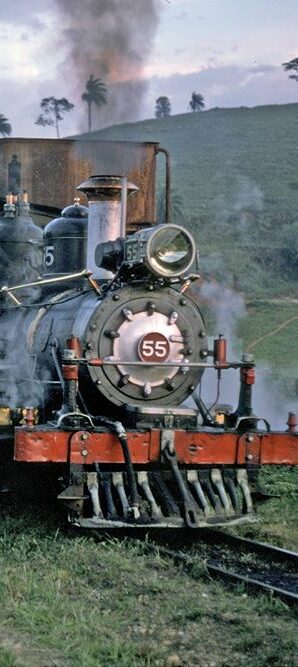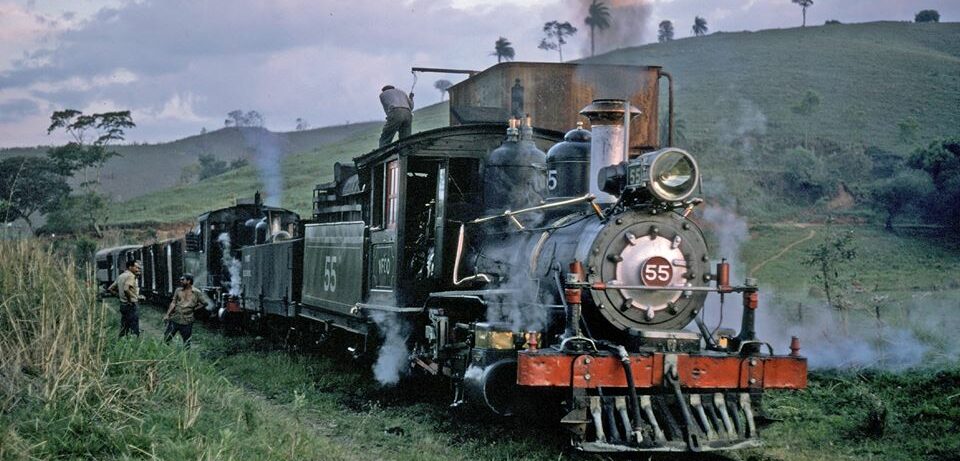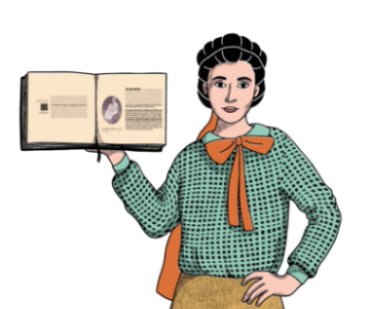ALL ROADS LED TO SÃO JOÃO
By the early 19th century, São João del-Rei had become a major commercial hub, complete with a direct route to Rio de Janeiro, the capital of Brazil at the time. São João del-Rei was not only a center for production of diverse goods such as manganese, potatoes, and manioc, but it also served as a crucial distribution point among various regions. The demand for trade continued to grow, underscoring the city's central role in regional commerce. In Minas, local commerce coveted products and goods considered modern that were only available in the capital. In Rio de Janeiro, the demand for food produced here was high. These needs, coupled with the aspirations for "progress" and "modernization" in Brazil, created the ideal context for the establishment of a railway line along this route. This development would facilitate trade and passenger traffic, significantly enhancing connectivity. Consequently, São João was selected as the headquarters for the railway that aimed to connect the western part of Minas Gerais to Rio de Janeiro: EFOM - Estrada de Ferro Oeste de Minas.
Incentives for Railway Construction
In 1872, Minas Gerais law no. 1,914 provided economic incentives to encourage the construction of the new railway. The concessionary company could choose between receiving 7% annual interest on total capital exceeding 4,000 contos de réis or a subsidy of 9 contos de réis per kilometer of track laid. Luiz Augusto de Oliveira and José de Rezende Teixeira Guimarães were the first to mobilize. On March 31, 1877, in what is now known as the Grand Hall of São João del-Rei's City Hall, concessionaires and entrepreneurs came together to form Companhia Estrada de Ferro d’Oeste (Western Railway Company). The company opted to receive the 9 contos de réis per kilometer, as outlined in the law.
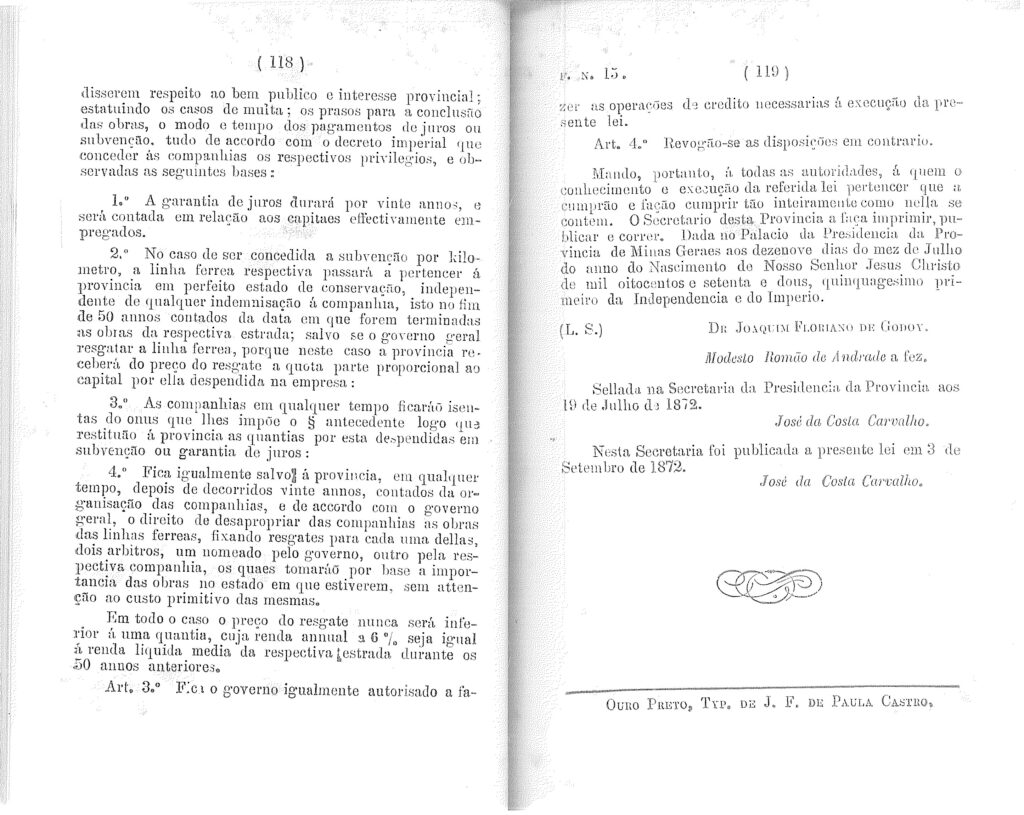
LAW No. 1914 by MINAS GERAIS GOVERNMENT.
From the Collection of Laws of the Legislative Assembly of the Province of Minas Gerais from 1872, pages 65 and 66.
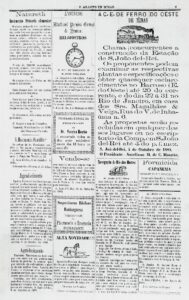
COMPANHIA ESTRADA DE FERRO DO OESTE DE MINAS (WESTERN MINAS RAILWAY COMPANY) CALLS FOR INVESTORS TO THE CONSTRUCTION OF THE S. JOÃO DEL-REI STATION.
Newspaper O Arauto de Minas, No. 30. YEAR 4, October 9, 1880. Brazilian National Library Collection.
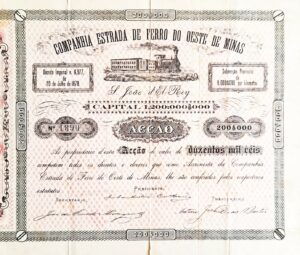
Purchase Shares of Companhia EFOM.
June 20, 1878. Adilson C. Paes’ personal collection.
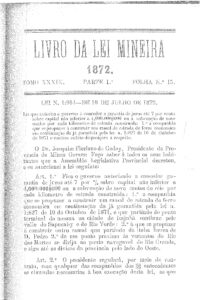
LAW No. 1914 by MINAS GERAIS GOVERNMENT.
From the Collection of Laws of the Legislative Assembly of the Province of Minas Gerais from 1872, pages 65 and 66.
Will the Railway Pass Through Here?
In 1877, a dispute arose between São João del-Rei and the planned route of Estrada de Ferro D. Pedro II (D. Pedro II Railway), intended to connect to a navigable point on the São Francisco River. The goal of this railway was to encompass extensive areas within the provinces and establish a rail network connecting key parts of the country. Speculation in the pages of O Arauto de Minas about the railway's future emphasized São João del-Rei's strategic importance in accessing products from economically prosperous regions of Minas Gerais. Ultimately, the city was excluded from the railway’s path, although its economic and strategic significance had been highlighted. The concession that led to the formation of Companhia Estrada de Ferro d’Oeste was revived and pushed forward, while Estrada de Ferro Dom Pedro II was rerouted towards Queluz (now Conselheiro Lafaiete), aiming for the São Francisco River via the route known as Taipas.
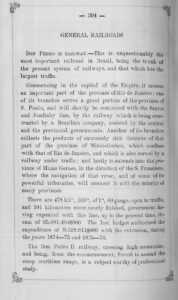
THE BRAZILIAN EMPIRE AT THE PHILADELPHIA UNIVERSAL EXHIBITION IN 1876.
Typography and Lithography by Imperial Artistic Institute. Collection of the Library of Congress, The United States and Brazil: Expanding Frontiers, Comparing Cultures, 1876.

Brazilian Empire, Philadelphia Universal Exhibition, 1876.
Typography and Lithography by Imperial Artistic Institute. Collection of the Library of Congress, The United States and Brazil: Expanding Frontiers, Comparing Cultures, 1876.
ANTICIPATION FOR THE INAUGURATION.
A festive excitement spread through the streets of São João del-Rei as the eagerly awaited inauguration of Estrada de Ferro Oeste de Minas approached. Men and women rented formal attire specifically for the occasion. Hotels and boarding houses filled up, and everyone prepared. Chosen by EFOM as the hub for the most modern and technological venture of the time, the railway, São João was in the spotlight, showcasing its importance to the economy and politics of the Second Empire. Dom Pedro II was en route to the city, and the connection of the Minas Gerais interior with the capital and its court in Rio de Janeiro was materializing along the tracks. The European ideas of "modernity" and "progress" were arriving, propelled by the steam of the new railway.
Even though it reflected the efforts of a bourgeois elite seeking so-called "progress" after the decline of gold mining, the railway's construction represented a victory for the entire city as the tracks would reduce distances and freight costs.
Even though it reflected the efforts of a bourgeois elite seeking so-called "progress" after the decline of gold mining, the railway's construction represented a victory for the entire city as the tracks would reduce distances and freight costs.
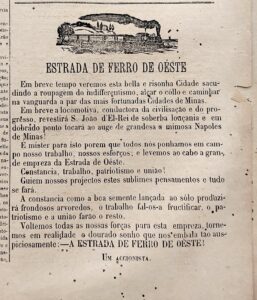
WESTERN RAILWAY: WESTERN RAILWAY: The Locomotive as a Conductor of Civilization.
NEWSPAPER O ARAUTO DE MINAS. Year I, No. 37, November 18, 1877, p. 3. Brazilian National Historical and Artistic Heritage Institute of São João del-Rei Archive.
The Inaugural Train that Brought D. Pedro II
Streets decorated, colorful and flowered. The streets were vibrant with decorations and blooms as a crowd eagerly awaited the train's whistle at the newly constructed Western Minas Station. At 10 pm on August 28, 1881, the distant sound of a whistle followed by plumes of smoke heralded the arrival of Locomotive No. 01, piloted by train driver Felipe Marcheti. The inaugural train of Estrada de Ferro Oeste de Minas rolled into São João, carrying Emperor Dom Pedro II, Empress Dona Tereza Cristina, and their extensive royal entourage, which included ministers, advisers, parliamentarians, engineers, and journalists. The arrival sparked widespread celebration and a warm welcome from the throng of spectators. The emperor and the entire Royal Court retired to their quarters to rest before the grand inauguration scheduled for the next day.
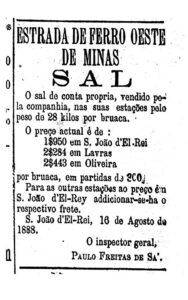
WESTERN MINES RAILWAY, SALT
Newspaper O Arauto de Minas, november 10, 1880. Hugo Caramuru’s personal collection.
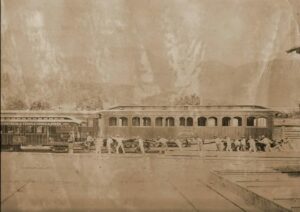
WAGON THAT TRANSPORTED DOM PEDRO II IN THE WORKSHOPS
Author unknown, 1880. Gustavo Zenquini's personal collection.
"Artistically adorned floral arches were erected on the streets. Dom Pedro II, who was fond of São João del-Rei, attended the inauguration of the first EFOM railway segment from Sítio, now Antônio Carlos, to São João del-Rei, covering approximately 100 kilometers. It's worth noting that Estrada de Ferro Oeste de Minas, a genuinely local initiative, has provided excellent services to Brazil's transport sector."
Sebastião de Oliveira Cintra, in the book Efemérides de São João del-Rei of August 28, 1881 (Chronicles of São João del-Rei from August 28, 1881), published in 1963.
"THE SECOND VISIT OF THEIR MAJESTIES TO SÃO JOÃO DEL-REI
The day of August 28th was marked as a joyful milestone in the city's history
celebrating the inauguration of the vital railway connecting São João del-Rei with the centers of civilization, pushing us to the forefront of advanced nations along the long road of progress. [...]
From five in the afternoon, the city's streets swelled with a dense crowd resembling a powerful torrent, flooding the station plaza in anticipation.
Along the tracks, a thick line of eager spectators jostled impatiently, waiting for the Imperial train. [...]
At 10:05 PM, the locomotive's whistle heralded the arrival of the beloved Sovereigns and their distinguished guests, who came to share the genuine joy of an exuberant population.
The air filled with numerous fireworks, and the 21-gun salutes joined with the sounds of martial music to create a rousing celebration."
NEWSPAPER O ARAUTO DE MINAS, São João del-Rei, September 3, 1881., São João del-Rei, 03/09/1881.
The Inauguration That Never Was
The community eagerly awaited the inaugural festivities of the EFOM, planned for the morning after the inaugural train's arrival. Everyone was dressed in their finest attire, shoes shined, and hairstyles carefully arranged; streets, homes, and the station were festively adorned, ready for the significant event. Unfortunately, the excitement was short-lived. That evening, while heading to his quarters, Buarque Macedo, then Minister of Agriculture, suddenly fell ill. Around midnight, the Emperor was told that the minister would not survive. Due to Macedo's unexpected death, the Emperor canceled all the events and, with his entire entourage, departed the city. Interestingly, Revista Ilustrada had published a lithograph announcing the inauguration the day before the event, which ultimately never took place.
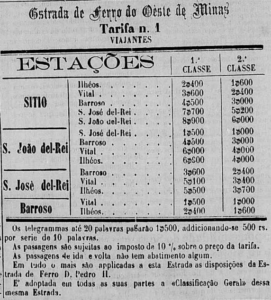
NEWSPAPER O ARAUTO DE MINAS, São João del-Rei, September 18, 1881, p. 4. Brazilian National Library Collection.
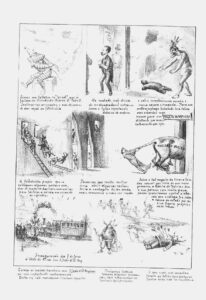
INAUGURATION OF WESTERN MINAS RAILWAY IN SÃO JOÃO D'EL REI.
Revista Ilustrada, Anno 6, n. 262, 1881, p. 7. Brazilian Digital Newspaper Library.
"Dr. Rameiro's brother, who is a doctor and was also staying at the house, was called too late: nothing more could be done. For some time, the patient hovered between life and death, eventually sighing, 'my poor family'... The Emperor only had time to comfort him briefly about their future. In the early hours, Dom Pedro returned through the decorated streets to his lodgings, and the next morning, his carriage took him back to the station. All other festivities were canceled."
Ina von Binzer, in the book Os meus romanos: alegrias e tristezas de uma educadora alemã no Brasil [My Romans: Joys and Sorrows of a German Educator in Brazil (1881-1884)], published in 2017.
São João, Headquarters of the Grand EFOM
São João Station emerged as a crucial commercial hub and a connector to the Dom Pedro II railway line, boosting demand for services and products in the region. Situated at the center of Minas Gerais' main railway, the city showcased its significance for the economic and political landscape during Brazil's Second Empire. EFOM was instrumental in connecting cities and communities along its route, enhancing access to services, markets, and opportunities. After its inauguration, the company expanded significantly, operating in previously unconnected regions and reducing travel distances and logistical challenges. In 1920, EFOM extended its reach by acquiring the Goyas Railway, increasing its network to about 544 kilometers.
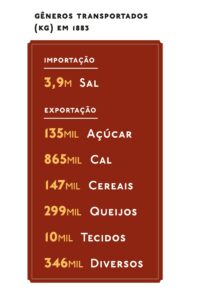
Genres transported (KG) in 1883
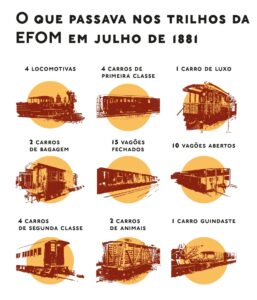
What Traveled the Tracks of EFOM in July 1881
Locomotive No. 1
Locomotive No. 1 holds significant historical importance for EFOM and the inauguration of the São João del-Rei Station. In 1881, it took Emperor Dom Pedro II to the opening event, traveling from Sítio on the Estrada de Ferro Dom Pedro II to São João del-Rei.
In 1959, the locomotive was taken to Belo Horizonte, where it was installed as a monument at the Rede Mineira headquarters. With the creation of the Railway Museum by PRESERVE in 1981, it was returned to São João del-Rei. In the capital, it was replaced by locomotive No. 20, a monument from the Lavras workshops (MG)
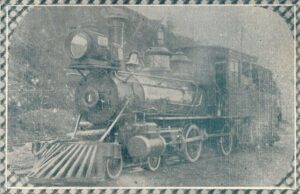
LOCOMOTIVE No. 01 IN THE SÃO JOÃO YARD
Múcio Jansen Vaz, 1922. Published in the book "Estrada de Ferro Oeste de Minas - Trabalho Histórico- Descriptivo" (Western Minas Railway – Historical-Descriptive Work)
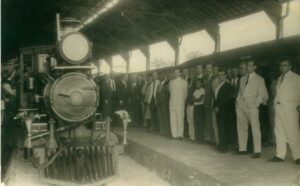
LOCOMOTIVE NO. 1 ON ITS FAREWELL JOURNEY
Author unknown, 1958. Gustavo Zenquini's personal collection.
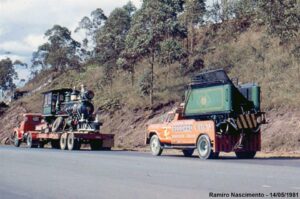
LOCOMOTIVE 01 RETURNING TO SÃO JOÃO DEL-REI
Ramiro Nascimento, May 14, 1981. Gustavo Zenquini's personal collection.
Baldwin Locomotive Works
Baldwin Locomotive Works was established in 1825 by Matthias W. Baldwin in Philadelphia, Pennsylvania. Renowned for its railway machinery, the company played a significant role in advancing railroad development in America and enhancing steam transportation technologies. During its operation, spanning 25 years, Baldwin produced over 75,500 locomotives before ceasing operations in 1956.
The locomotives for Estrada de Ferro Oeste de Minas were initially Baldwin models, giving the line an edge with components fully manufactured in the United States, unlike other Brazilian rail lines at the time that used European-made locomotives.

Baldwin Locomotive Works
J.B. Lippincott & Co, 1875. Internet Archive collection.
The Narrow Gauge
Gauge is the internal distance between two rails on a track. There are several gauge sizes, each determining the type of train that can operate on that track. While planning and constructing EFOM, it was decided that a narrow gauge would be used, despite the need to integrate with the broad-gauge Dom Pedro II railway. Known as "bitolinha," this gauge measured 762 millimeters, or 2 feet 6 inches—30 inches. Commonly used in railroads in other countries, this gauge was chosen for its lower construction costs and ability to accommodate the tight curves suitable for Minas's mountainous terrain. It also required less material, making it more economical. However, due to its uniqueness, the equipment for this gauge was challenging to modernize, turning the São João del-Rei railway complex into a veritable "railroad fossil."
"At the festooned and flag-decked station, a band (mostly Germans) played wind instruments joyfully; [...] One entire street made itself beautiful by decorating with troughs painted green and yellow, in which, among the green palms, a torn flag fluttered. Only the path from the station to the city was adorned on both sides with slender columns, decorated in green and yellow with delicate, very pleasant-looking small flags."
Ina von Binzer, in the book Os Meus Romanos: alegrias e tristezas de uma educadora alemã no Brasil [My Romans: Joys and Sorrows of a German Educator in Brazil (1881-1884)], published in 2017., em Os meus romanos: alegrias e tristezas de uma educadora alemã no Brasil (1881-1884).





